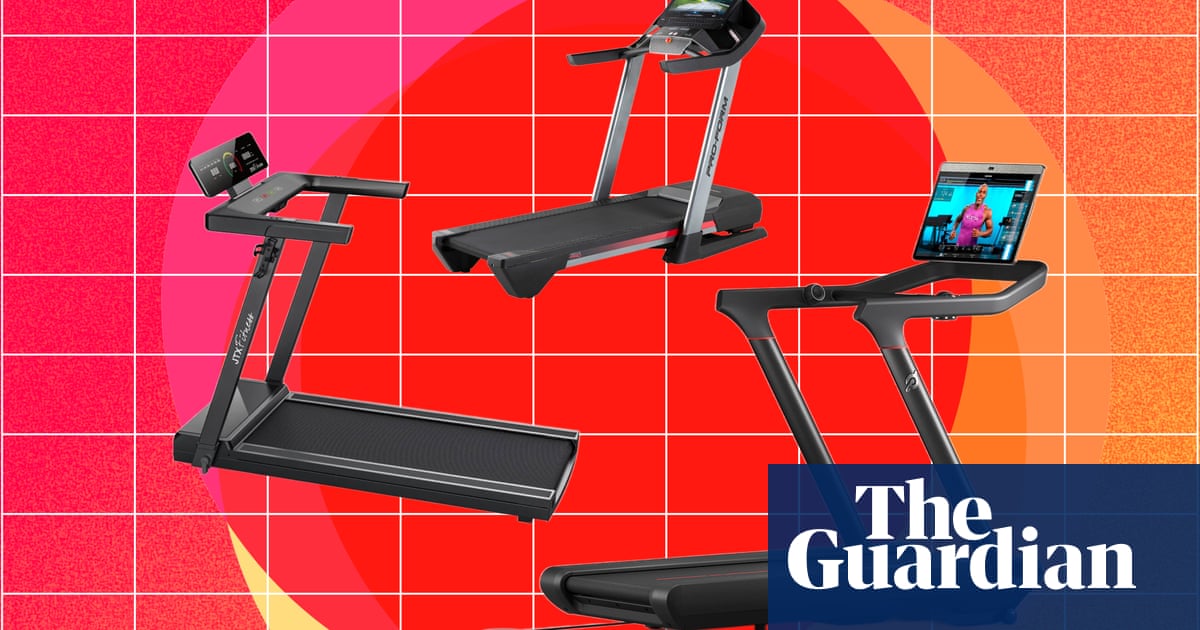Although the treadmill has been around since the early 1800s, when it was once used to punish prisoners (sounds about right), it didn’t become a common feature in the home until the late 1960s, when William Staub unleashed his PaceMaster 600 on the US public.
Where they were once a simple rolling deck, treadmills today are often glossy pieces of interactive tech. Many now offer on-demand, real-time workouts (pioneered by Peloton) and the latest blockbuster movies via streaming services. Even if your treadmill doesn’t sport a whopping touchscreen display, it probably works nicely with heart-rate monitors, smartwatches and smartphone apps to track workouts and offer performance statistics after every session.
Running decks have become more cushioned to offer better joint protection, and motor technology is now quieter and more efficient than ever. A treadmill still takes up a fair amount of space, but there are now compact folding options to help tackle this.
The best treadmills on sale now are a far cry from those torturous devices designed to make the incarcerated sweat away their sins, offering ingenious ways to keep fit and, perhaps more importantly, make fitness more fun.
At a glance
Why you should trust me
As a fitness fan partaking in gym-based strength training, outdoor trail runs, kickboxing classes and cold-water surfing, I have long been tasked with testing exercise gear for leading fitness and technology magazines.
Whatever I’m testing, I’ve always been one to get stuck in, whether that’s surfing with the latest smartwatch in cold weather or feeling the burn with a set of connected kettlebells.
I’m a strong believer in living with new-fangled tech to get a grasp of how it fits into daily life, so I’ve always sought to test a product for as long as possible and in the right environment. When it comes to treadmills, that has been to the detriment of any additional storage space my terrace house offers.
How I tested
Without wanting to become a “first-world problems” meme, testing treadmills isn’t easy. They’re massive, for one, which means logistical management in having them delivered and then collected.
I tested all the treadmills on this list over several months, trialling some systems for weeks, and others over a couple of arduous sessions. Where I could introduce a model to my home, I did. If it didn’t fit there, it was shoehorned into an office space I rent.
Failing that, I arranged to get hands-on (or should that be feet-on?) with a model at the manufacturer’s headquarters or a dedicated showroom. One of the treadmills was handily used by my local gym.
With every treadmill, I aimed to test all the connected features, typically pairing a smartwatch (Apple and Garmin) and a chest-based heart-rate monitor, as well as trialling any on-demand video and audio services. Where relevant, I tried live and on-demand workouts on any subscription packages and any gamified content available.
During each test, I aimed to rack up as much mileage as possible, sweating it out over longer runs and more intense sprint sessions. If an elevation feature was available, I activated it, and if there was sled or resistance training, I’d dive into that too.
Most of the treadmills were tested in a space where I could assess how much noise they made when in use, rather than trialling them in a busy gym where the thump of a deck or the whine of an electric motor is typically drowned out by background noise.
All of the units were only ever offered to me on a loan basis, so they’ve made their way back to their respective owners. Due to this, it would be wrong of me to comment on their longevity or ability to withstand years of abuse, although I did get a good feel for build quality in the time I spent with them.
For more ways to keep fit without leaving the house, read our PT-recommended guide to the best home exercise kit
The best treadmills in 2025
Best treadmill overall:
Peloton Tread
Peloton arguably dragged the treadmill into the 21st century when it launched the Tread. The brand ushered in a new era of on-demand classes led by real instructors, accountability in the form of live leaderboards and a plethora of engaging workouts able to be performed anywhere and at any time.
Who knew that bolting a big touchscreen to a fairly standard treadmill would cause such a stir? However, Peloton sales soared during the pandemic and it continues to be one of the best products for most people, beginners and seasoned runners alike. As a result, it has spawned several rivals.
Why we love it
Peloton’s treadmill itself is a neat piece of equipment, with its compact and easy-to-live-with design slotting into most domestic settings. The unit is competitive in terms of its top speeds and max incline (20km/h and 12.5% grade), while two simple roller mechanisms control both. During some sessions, the Tread will automatically adjust, depending on the goals.
Although neither the quietest nor the most cushioned deck to run on, this machine majors in its expansive All-Access membership. This opens up a world of on-treadmill training sessions, live classes hosted by instructors who have now gained quasi-celebrity status, and in-depth training programmes covering everything from couch to 5K up to marathon prep.
Should you not feel like being instructed by a bubbly, gorgeous and irritatingly tanned personal instructor, you can always binge movies, audiobooks and live and on-demand TV shows by harnessing the Peloton Entertainment app offering, or pump a popular music playlist from the impressive 26W front-facing speakers. This is all delivered via the crisp 23.8in full colour, high-definition touchscreen.
Although there are now rivals that offer a similar level of interactivity and technology, few have managed to nail the execution quite like Peloton. It’s fun, engaging, highly polished and motivating, all at the same time. Above all else, it’s addictive – and surely that’s all you can ask for in the quest to keep fit.
It’s a shame that … it’s expensive, and membership to online classes costs an additional £39 a month.
Dimensions: 84 x 173 x 157cm (WLH)
Weight: 132kg
Running area: 50 x 150cm
Max speed: 20km/h
Max incline: 12.5%
Folding: no
Built-in entertainment: yes, through Peloton’s dedicated Entertainment app
Best budget treadmill:
JTX Slimline
If you can overlook the fact that this doesn’t feel as robust as its larger, static rivals (see below), this Slimline model from JTX is perfect for those who lack the space at home for a full-size treadmill – it folds completely flat and can easily be moved into storage when not in use.
The company also offers an incline version, which feels surprisingly stable at maximum incline when running, but this cheaper and more basic option is perfect for those who prefer jogging, lower-impact training or simply those who want to increase their step daily count.
With a 16km/h top speed, it’s no slouch, but the narrow deck and 1.75hp motor won’t suit those hoping for a more punishing workout.
Why we love it
Unlike so many treadmills available today, the JTX Slimline is compact and lightweight, making it relatively easy to wheel around tighter spaces. After all, not everyone is blessed with a dedicated gym at home, so we often have to make do with a temporary setup in the living room. The Slimline is perfect for this.
The machine folds completely flat when it’s not in use, and it can be propped against a wall or tucked away in a cupboard to keep it out of sight. It features an impressive top speed, which is great for something so compact, while the small performance motor is relatively quiet.
Users will have to bring their own entertainment in the form of a tablet or music played through headphones, but the unit does feature built-in Bluetooth so it can relay running data to accompanying apps, such as Strava or the Zwift virtual running software.
It’s a shame that … it feels a little too flimsy to endure serious sprint training, yet it’s too large and bulky to take the place of a simple walking deck for daily step-count enthusiasts.
Dimensions: 70 x 152 x 125cm (WLH)
Weight: 43kg
Running area: 45 x 122cm
Max speed: 16km/h
Max incline: 0%
Folding: yes
Built-in entertainment: no
£599 at JTX Fitness
Best for gym quality:
JTX Sprint-9 Pro
JTX likes to pride itself on offering commercial-grade fitness equipment for those on a domestic budget. The resulting kit is built to last, comes with a generous warranty and provides a similar experience to what you might find in your local gym.
The Sprint-9 Pro may lack the bells, whistles and interactive touchscreens of more expensive rivals, but it has a generously sized running deck, a powerful 4hp brushless motor, and a whopping 22km/h top speed at an 11% max incline.
Why we love it
With its punchy motor and serious incline, this treadmill makes it possible to achieve a challenging workout without a fitness professional telling you what to do. You can always set up a tablet or smartphone to indulge in a Peloton-esque experience with the appropriate apps and subscriptions, of course, but JTX also offers 36 preinstalled workout programmes for those who like to keep things slightly more analogue.
The build quality is excellent, the CushionStep running deck spacious and comfortable, and the built-in Bluetooth speakers make it possible to soundtrack a run when paired with a tablet or phone – just don’t expect Ibiza club levels of sound quality.
Don’t be fooled by its lack of an interactive screen: the Sprint-9 Pro still synchronises running data with services such as Zwift, Strava and Kinomap (as well as connecting to Bluetooth heart-rate monitors). You just have to provide your own technology to make the most of these features.
It’s a shame that … it doesn’t have easy-to-reach adjustment dials for speed and incline, and the built-in heart-rate sensors aren’t the most comfortable to hold.
Dimensions: 84 x 195 x 155cm (WLH)
Weight: 125kg
Running area: 55 x 152cm
Max speed: 22km/h
Max incline: 11%
Folding: no
Built-in entertainment: no
£1,699 at JTX Fitness
Best folding treadmill:
ProForm Pro 9000
Folding treadmills can lack the build quality and premium features of their non-collapsible counterparts, but the Pro 9000 is one of the few that aims to pack in the tech. A 3.6hp motor doesn’t want for power, offering a 22km/h top speed and a respectable 12% incline, while the deck features ReBound Pro Cushioning for a little flex underfoot to protect the joints.
There’s a compromise when it comes to running deck space, though, as it’s slightly narrower than larger, fixed treadmills. However, folding it up is a simple process and, when placed in its upright position, it can be rolled into a cupboard or stored up against a wall to free up space.
Why we love it
It’s easy to scrimp on features when producing a folding treadmill, but ProForm packs a lot in here … not to mention an impressive running experience. The motor is plenty powerful enough, with a top speed that rivals anything here, while the Digital Quick Decline/Incline control is great for brutal hill sprint sessions. The deck is great at reaching the desired incline or decline at speed.
ProForm has long partnered with iFit, which provides a similar on-demand and live workout environment to Peloton and Technogym. This can be accessed via the wifi-enabled 21.5in HD colour touchscreen display. Users will have to pay a separate monthly subscription, though.
after newsletter promotion
ProForm allows access to several streaming services with the touchscreen, as well as the ability to stream music through the twin 2in speakers mounted just below the screen. However, don’t expect mind-blowing performance from these, as it’s often best to stick a pair of headphones on instead.
It’s a shame that … it’s not lighter to make packing away a little easier – and the built-in cooling fan is borderline useless.
Dimensions: 90 x 196 x 151cm (WLH)
Weight: 119kg
Running area: 51 x 152cm
Max speed: 22km/h
Max incline: 12%
Folding: yes
Built-in entertainment: yes
The best of the rest
Decathlon Domyos T900D
Best for: running app aficionados
The T900D is one of the sports brand’s most robust units. It offers pro-grade running speeds and max inclines that can rival more expensive treadmills, and it folds for convenient storage.
It lacks the connected pizazz of some of the models I’ve tested, and the big, often difficult-to-operate buttons and basic display make it feel like a throwback to treadmills of yore. Yet it performs admirably, offering a generous deck for taller people, as well as simple connectivity with third-party apps, such as Strava and Kinomap.
It didn’t make the final cut because … the build quality isn’t as hardy and it’s not the nicest piece of design.
Dimensions: 88 x 185 x 147cm (WLH); weight: 89kg; running area: 50 x 143cm; max speed: 18km/h; max incline: 10%; folding: yes; built-in entertainment: no
£899.99 at Decathlon
Life Fitness T3
Best for: withstanding everyday use
Life Fitness is a common sight in UK gyms and this exact model is in place in one of the fitness facilities I use weekly. It has a basic LCD display that provides all the running data most users demand, and sessions can be programmed, with control over incline and speeds.
The build quality is excellent – it’s able to withstand regular punishment – but that is reflected in the price, especially considering the rather basic nature of its built-in programs and lack of connected features. This is just a good old-fashioned treadmill, which is less likely to cause reliability headaches than some cheaper rivals.
It didn’t make the final cut because … it looks great in a commercial gym, but it’s too basic and bulky for the home.
Dimensions: 88 x 202 x 147cm (WLH); weight: 111kg; running area: 51 x 153cm; max speed: 19km/h; max incline: 15%; folding: yes; built-in entertainment: no
£2,632 at Gym Equipment
£2,995 at Best Gym Equipment
NordicTrack EXP5i
Best for: immersive training without the big screen
This is another folding option that follows the ProForm line of thinking – chiefly, a solid running experience without the additional cost of a large touchscreen display. Instead, users are encouraged to tether a smartphone or tablet and make the most of the iFit app, which requires a monthly subscription but opens up the chance to take part in live classes and on-demand workouts. Weighing 90kg, the EXP5i is, however, lighter than the ProForm Pro 9000, and I found it easier to wheel around. The build quality is also excellent.
It didn’t make the final cut because … the running deck is shorter and narrower than many competitors, while the 16km/h top speed will disappoint sprinters.
Dimensions: 87 x 180 x 152cm (WLH); weight: 90kg; running area: 51 x 140cm; max speed: 16km/h; max incline: 10%; folding: yes; built-in entertainment: no
£999 at Fitness Superstore
£999 at Gym Equipment Superstore
Technogym Run
Best for: premium quality and all-encompassing workouts
This Italian manufacturer loves nothing more than taking standard gym kit and injecting it with some serious, athlete-inspired smarts. The latest Technogym Run features a slat belt deck, which is not only more cushioning on the knees and other joints but also offers the quietest indoor running experience I have ever tested.
Sitting at the very premium end of the spectrum, many will balk at the Run’s asking price. But this machine goes beyond merely offering a platform to run on, thanks to its ability to mimic a weighted sled with its Multidrive resistance technology. When set in this mode, users can strengthen muscles in the lower body or intersperse sled work with sprints for high-intensity interval training.
In addition, Technogym offers access to all its live and on-demand classes, scenic virtual runs and off-tread workouts, which include strength training, yoga and more. Pair it with the firm’s other intelligent fitness equipment and you’ll have one of the smartest setups around.
It didn’t make the final cut because … it’s priced way beyond what most mere mortals can afford.
Dimensions: 83 x 197 x 175cm (WLH); weight: 207kg; running area: 51 x 173cm; max speed: 25km/h; max incline: 15%; folding: no; built-in entertainment: yes, with the Technogym app store allowing access to YouTube, Disney+, Spotify and many more
£10, 340 at Technogym
What you need to know
How much should I spend?
There’s a treadmill to suit most budgets, but those with touchscreen displays and interactive features will cost more. The same goes for the most powerful motors, advanced running deck technology and greater connectivity features, as these all demand healthier budgets.
The most affordable treadmills generally start at £300-£400 – anything less than that isn’t typically worth your money. Prices then rise to £3,000 or more (see the Technogym Run) for the most technologically advanced and commercial-grade units.
How much room do you need?
The smallest treadmill on this list still measures 70 x 152 x 125cm (WLH) and you will want to factor in some wriggle room around that to ensure your arms aren’t bashing against a wall and your head isn’t hitting the ceiling. If storage space is a problem, take a look at the folding treadmills on this list. Typically, they fold flat and feature wheels so that they can be rolled into a more convenient space and stored upright to keep the floor clear.
What features should I look out for?
More serious runners should look at more powerful motors because they often provide the fastest running speeds and a more natural running experience. Incline and decline features are great for mimicking runs out in the wild, and a well-cushioned deck is important for protecting the joints.
Most manufacturers don’t cite figures for decibel levels emitted during operation, but it’s worth considering that some treadmills are quieter than others. Finally, connected features are fantastic for keeping track of training, ensuring runs are interesting and generally entertaining during an arduous workout. However, that doesn’t mean you necessarily need a massive display, as tethering a tablet or a smartphone can do just as good a job.
Venturing outdoors? Bundle up and break a sweat with our winter running essentials.
Leon Poultney has been traversing the worlds of consumer technology and automotive for some of the biggest lifestyle websites and magazines for longer than he cares to divulge. A lifelong fitness enthusiast, he can often be found trying not to injure himself on a mountain bike/surfboard/other extreme thing, often at the request of an editor. Whether it is getting to know the latest connected kettlebells or partaking in CrossFit sessions, Leon is always willing to put his body on the line for great editorial










